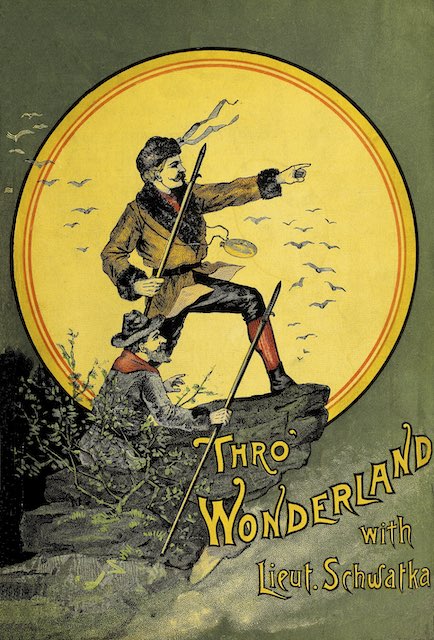The intrepid-looking fellow standing on the cover of Northern Pacific’s 1886 Wonderland booklet is supposed to be Frederick Schwatka, who is credited with writing more than half the booklet. As a U.S. Army lieutenant, Schwatka achieved fame for leading the initial calvary charge in the Battle of Slim Buttes, the army’s first victorious battle after the Custer debacle. Later, he became known for exploring the arctic and Alaska.
 Click image to download a 60.1-MB PDF of this 104-page booklet.
Click image to download a 60.1-MB PDF of this 104-page booklet.
Thanks to Schwatka’s lengthy report on his travels in Alaska, the 1886 booklet was 104 pages, up from 68 in 1885. The first 44 pages of text, a travelogue of sights between Minnesota and the Pacific Northwest, were by John Hyde and were only modestly changed from the 1885 booklet (but in 1886 Hyde at least received credit for his work).
Before the Klondike gold rush of 1897, it is unlikely that more than a few handfuls of tourists took the Northern Pacific to Seattle so they could go on to Alaska. The growth of the Alaska section of the Wonderland booklet from less than 10 pages in 1885 to 48 pages in 1886 must have been due to NP’s deciding to take advantage of Schwatka’s celebrity to get more people to read the booklet in the hope that some of those people to ride its trains.
Born in Illinois in 1849, Schwatka moved with his family to the newly created state of Oregon when he was 10 years old. After graduating from West Point in 1871, he obtained degrees in both law and medicine, making him one of the best credentialed people in the country. In 1878-1880, he led an expedition to the Canadian Arctic searching for (and finding some evidence of) Franklin’s lost expedition of 1845.
In 1883, the army asked him to explore deep into Alaska. He led a group over Chilkoot Pass (of later Klondike Gold Rush fame) and then down the Yukon River 1,300 miles to the Bering Sea, the longest raft trip that had ever been made. He would never know that he passed right by the gold fields that would be discovered along the Yukon River in 1896, as he died in Portland in 1892, some say of suicide. Before that, however, Schwatka visited Alaska again in 1885, which may have been what stimulated the NP to add his report to this booklet.
Despite the credit to Schwatka, the informal and florid nature of the writing in this booklet makes me suspect that the Alaska portion was largely written by Hyde based on reports Schwatka wrote for the Army. If so, since government reports aren’t copyrightable, Schwatka wouldn’t even have been paid for his share of the booklet.
Note that the title on the cover abbreviates “through” as “thro” and uses an apostrophe to indicate that abbreviation. Today, we would use “thru” without an apostrophe.
archive.org has images of two copies of this booklet. Neither were in great condition; I digitally repaired the covers and lightened up some of the pages. Still, archive.org’s PDFs are smaller so if you have a slow connection or limited disc space, you may want to download one of theirs.
